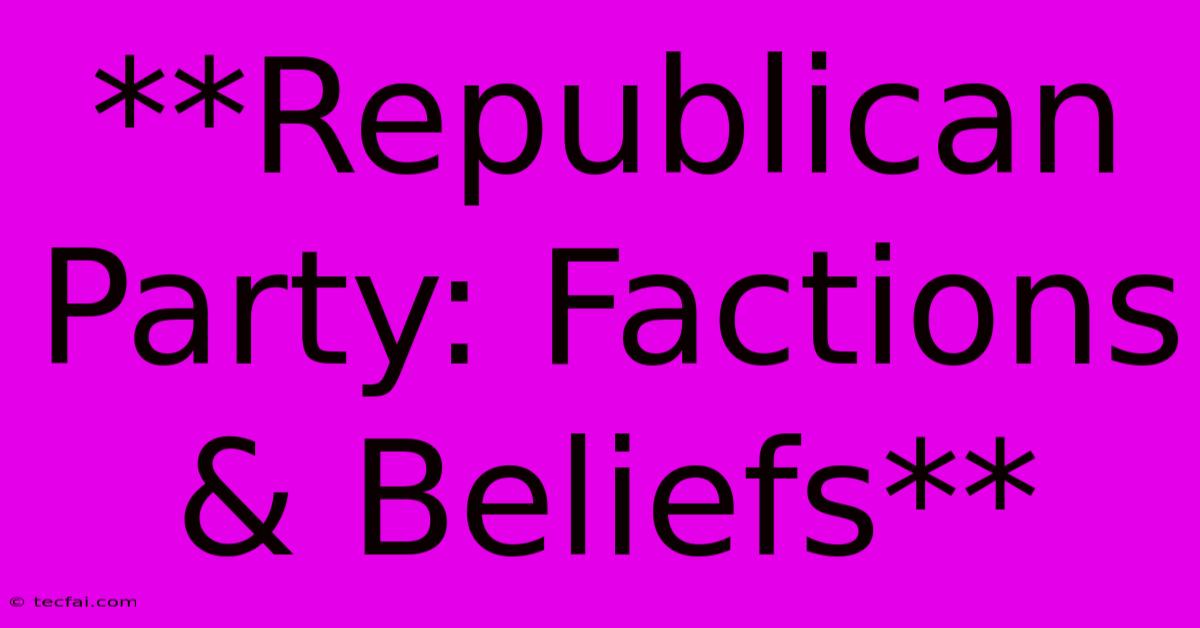**Republican Party: Factions & Beliefs**

Discover more detailed and exciting information on our website. Click the link below to start your adventure: Visit Best Website tecfai.com. Don't miss out!
Table of Contents
Republican Party: Factions & Beliefs
The Republican Party, one of the two major political parties in the United States, is known for its conservative stance on various issues. However, within the party, there exist diverse factions with varying beliefs and priorities. Understanding these internal divisions is crucial to comprehending the Republican Party's current state and its future direction.
Major Factions Within the Republican Party
1. Establishment Republicans:
- Beliefs: Generally favor a more traditional approach to conservatism, prioritizing fiscal responsibility, limited government intervention, and a strong national defense. They often support free trade agreements and are generally more aligned with the business community.
- Key Figures: Mitt Romney, Susan Collins, Lisa Murkowski
- Examples: Support for free trade agreements like NAFTA, opposition to excessive government spending, and advocating for a strong military presence around the world.
2. Tea Party Republicans:
- Beliefs: Emphasize limited government, fiscal conservatism, and individual liberty. They advocate for lower taxes, smaller government, and a balanced budget.
- Key Figures: Ted Cruz, Rand Paul, Jim Jordan
- Examples: Strong opposition to government intervention in the economy, support for tax cuts and spending reductions, and opposition to government-funded healthcare programs.
3. Trump Republicans:
- Beliefs: Characterized by a populist, nationalist, and often anti-establishment agenda. They prioritize American economic nationalism, immigration restrictions, and a strong stance against perceived threats to American values.
- Key Figures: Donald Trump, Mike Pence, Steve Bannon
- Examples: Strong tariffs on imported goods, a focus on "America First" policies, and a hardline stance on immigration.
4. Social Conservatives:
- Beliefs: Focus on traditional moral values and social issues like abortion, same-sex marriage, and religious freedom. They advocate for policies aligned with these values, such as restrictions on abortion access and support for religious expression in public life.
- Key Figures: Mike Pence, Jim Inhofe, Rick Santorum
- Examples: Opposition to abortion rights, support for traditional family values, and defense of religious liberties.
5. Libertarian Republicans:
- Beliefs: Prioritize individual liberty and limited government intervention in both social and economic affairs. They advocate for minimal government regulation, free markets, and individual choice.
- Key Figures: Justin Amash, Thomas Massie, Rand Paul
- Examples: Support for drug legalization, opposition to government surveillance, and advocacy for free markets and limited government regulation.
Overlapping Beliefs & Internal Conflicts
While these factions represent different perspectives, there are also areas of overlap and shared beliefs. For instance, many Republicans share a commitment to fiscal conservatism and a strong national defense. However, internal conflicts arise due to different priorities and approaches within these shared beliefs.
For example, while most Republicans support fiscal conservatism, some advocate for deep cuts in government spending, while others prioritize tax cuts as a means of economic growth. Similarly, there are disagreements on the best approach to national defense, with some advocating for increased military spending, while others prioritize strategic diplomacy.
These internal conflicts can manifest as disagreements over policy proposals, intra-party rivalries, and differing views on the party's future direction.
Impact on the Republican Party
The presence of these factions influences the Republican Party's platform, policies, and overall political strategy. It shapes the party's approach to national issues, congressional negotiations, and electoral campaigns.
Understanding the different factions within the Republican Party is crucial for analyzing current political dynamics and predicting future trends. As the party navigates a changing political landscape, these internal divisions will continue to shape its priorities and impact its future direction.

Thank you for visiting our website wich cover about **Republican Party: Factions & Beliefs**. We hope the information provided has been useful to you. Feel free to contact us if you have any questions or need further assistance. See you next time and dont miss to bookmark.
Featured Posts
-
Vinicius Jr Ballon D Or Awaits Fight Continues
Nov 06, 2024
-
Man City Vs Sporting Champions League Live Updates
Nov 06, 2024
-
Lidl Christmas Ad A Heartwarming Holiday Message
Nov 06, 2024
-
Nike Zoom X Alpha Fly 3 Sa Metallic Medium Ash Na Kulay
Nov 06, 2024
-
Halalan 2024 Mga Resulta Ng Survey
Nov 06, 2024
